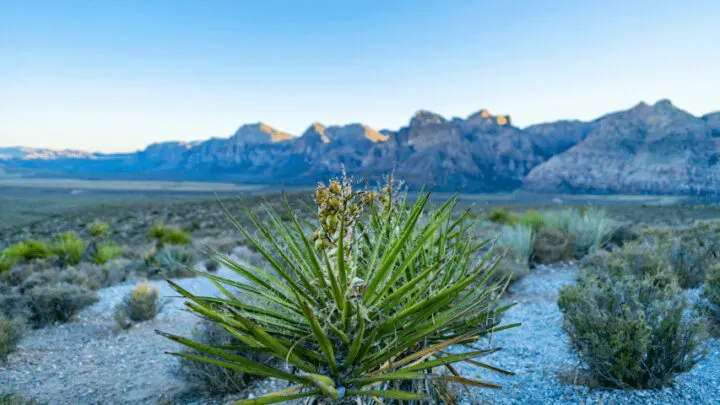Earth is a habitat for billions of species of various living organisms. Be it a desert climate or an aquatic setting, plants can grow almost everywhere.
Every plant is adapted to different climatic conditions and surroundings.
Plants that can thrive in the desert heat are quite adapted to low humidity conditions, low annual precipitation, and high temperatures throughout the day.
Talking about the desert plants, the Cactus is the first plant that pops to mind. Various other plants are capable of surviving in the desert heat.
Continue reading to find out about the 30 best plants that can thrive in the desert heat.
Table of Contents
30 Best Plants for Desert Heat
- Pancake Prickly Pear Cactus
- Barrel Cactus
- Saguaro Cactus
- Lace or Hedgehog Cactus
- Organ Pipe Cactus
- Brittlebush
- Creosote Bush
- Desert Ironwood Plant
- Desert Sage Plant
- Desert Marigold
- Desert Willow Tree
- Desert Lily
- Turpentine Broom
- Mojave-aster
- Jumping Cholla
- Joshua Tree
- Ocotillo
- Yellow Paloverde
- Triangle-leaf Bursage
- Desert Palm
- Tumbleweed
- Mesquite Tree
- Poison Ivy
- Date Palm
- Lovegrass
- Thyme
- Oleander
- Emu Bush
- Pinyon Pine
- Ficus

30 Best Plants for Desert Heat
Best Plants for Desert Heat
1. Pancake Prickly Pear Cactus
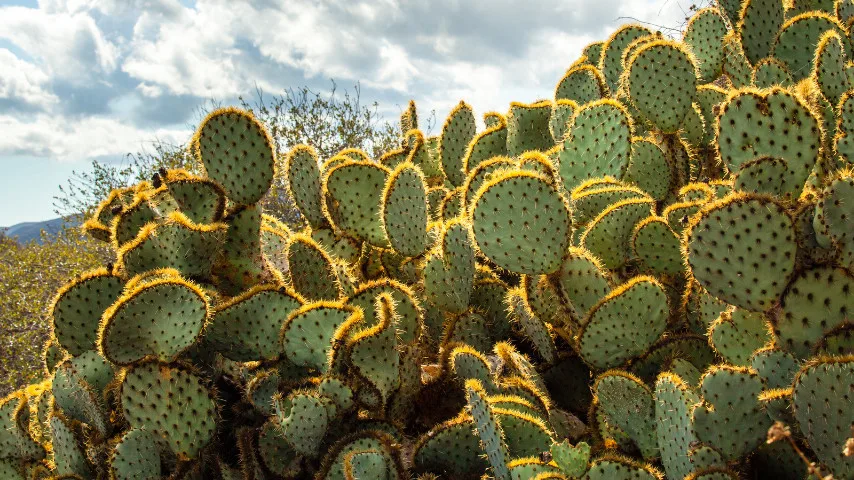
Pancake Prickly Pear Cactus adapted to areas where the sun emits direct heat and sunlight throughout the day
Pancake Prickly Pear Cactus is mostly found near the bordering regions of the United States and Mexico.
They are adapted to areas where the sun emits direct heat and sunlight throughout the day.
They can be described as pancakes with circular pads, with the ability to grow up to 7 feet.
According to the University of Berkeley, the Opuntia chlorotica has a tree-like growing habit.
Pancake Prickly Pear Cactus appears in many colors and variants depending upon climatic conditions and overall growth.
Scientific Name and Nomenclature
- Scientific name: Opuntia chlorotica
- Family: Cactus
- Temperature: 52-65°F (11-18°C)
- Fertilizer: No fertilizers required
- pH: 6-7.5
- Soil: Dry, gravelly, well-drained, or sandy
- Lighting: At least 6 hrs. of direct exposure to sunlight
- Growth rate: Slow
- Humidity: 0-10%
2. Barrel Cactus
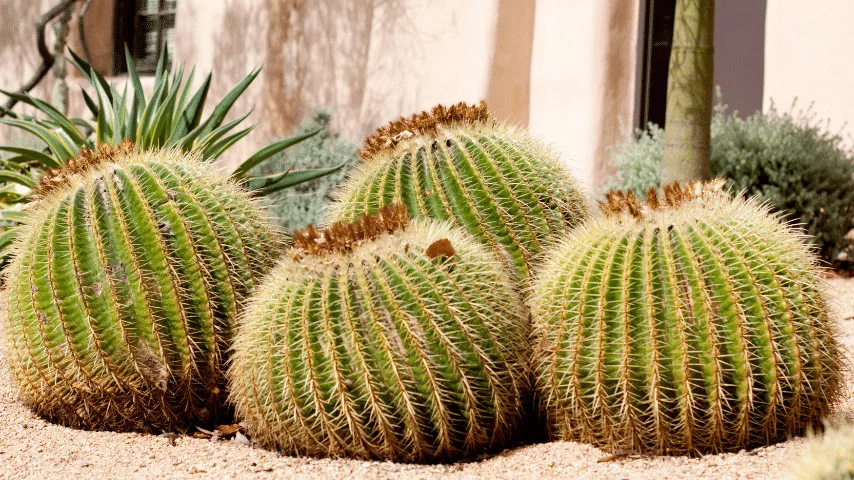
Barrel Cactus has an attractive flower towards its center, abundant in desert areas
Barrel Cactus are among the most popular varieties classified as succulents. Barrel Cactus are abundant in desert areas.
It has an attractive flower towards its center, which shines brightly over a green surface when under direct sunlight.
Barrel Cactus keeps away predators and wild animals with its sharp and poisonous needles.
Scientific Name and Nomenclature
- Scientific name: Echinocactus grusonii
- Family: Cactus
- Temperature: 50-75°F (10-24°C)
- Fertilizer: Nitrogen liquid fertilizer in a low amount
- pH: 6-7
- Soil: Sand
- Lighting: Bright sunny area or field
- Growth rate: Moderate
- Humidity: 0-10%
3. Saguaro Cactus
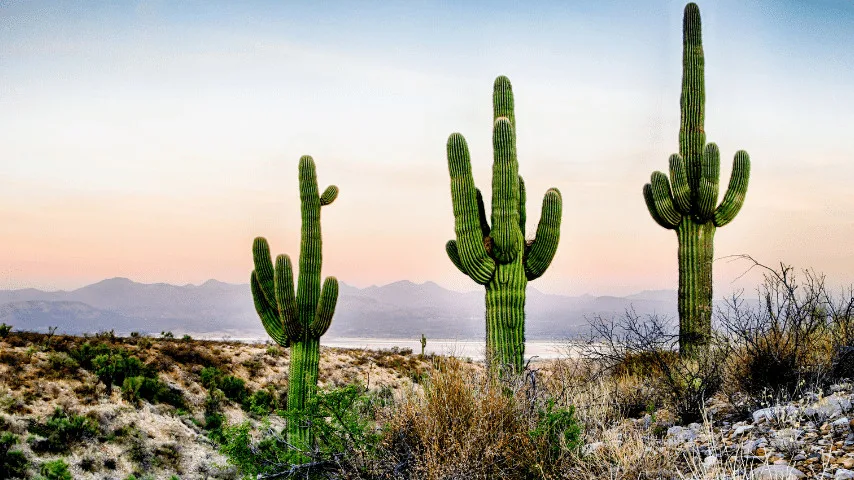
Saguaro Cactus thrives in desert heat as it adapted to hot and humid spells and long summers
Saguaro Cactus is known for its ideal growth rate and abundance in the US regions.
They can grow up to 40 feet tall if provided with ideal growing conditions and other environmental requirements.
Saguaro Cactus thrives in desert heat as it adapted to hot and humid spells and long summers.
Moreover, it’s capable of storing rainwater once in a while.
Usually, flowers in white and yellow color appear on its surface, adding beauty and color to its overall body.
- Scientific Name and Nomenclature
- Scientific name: Carnegiea gigantea
- Family: Cactus
- Temperature: Above 60°F (15.5°C)
- Fertilizer: No fertilization required
- pH: 7-7.5
- Soil: Loamy
- Lighting: 4-6 hrs. of uninterrupted sunlight
- Growth rate: Slow
- Humidity: 0-10%
4. Lace or Hedgehog Cactus
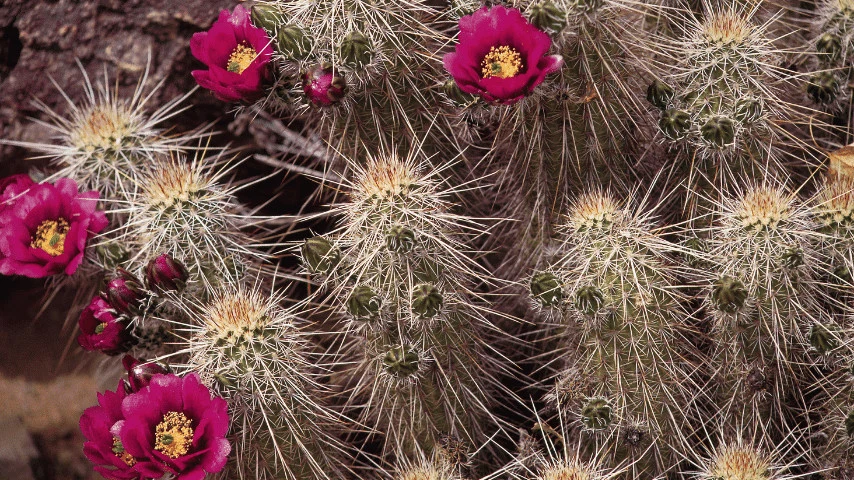
Lace or Hedgehog Cactus, changing shape as it grows and blossoms, producing vibrant flowers during the summer season
The Hedgehog Cactus is known for its changing shape as it grows and blossoms. The Lace cactus is a sphere initially but soon changes into a cylindrical shape.
They grow in groupings, producing vibrant flowers during the summer season.
Scientific Name and Nomenclature
- Scientific name: Echinocereus
- Family: Cactus
- Temperature: Above 50°F (10°C)
- Fertilizer: Potassium-rich fertilizer
- pH: 6.6-7.5
- Soil: Sandy
- Lighting: 8 hrs. of bright sunshine
- Growth rate: Slow
- Humidity: 0-10%
5. Organ Pipe Cactus
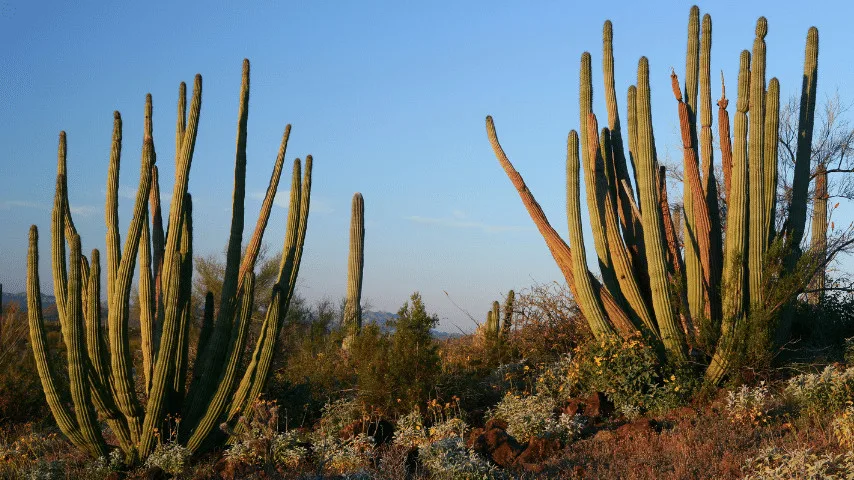
Organ Pipe Cactus only bloom during the night and thrives in well-drained soils, which remain mostly dry throughout the season
Organ Pipe Cactus is a source of oil-based compounds and proteins. They grow upwards, with their stiff roots in the ground.
As the plant achieves maturity, purplish and light pink flowers appear, which only bloom during the night when the temperature is below 25°C.
Organ Pipe Cactus thrives in well-drained soils, which remain mostly dry throughout the season.
They have the ability to store a limited volume of water in their stems, which helps the plant survive the extreme heat and drought conditions.
Scientific Name and Nomenclature
- Scientific name: Stenocereus thurberi
- Family: Cactus
- Temperature: Above 70-80°F (21-27°C)
- Fertilizer: Applying fertilizers is not necessary
- pH: 6.0-7.5
- Soil: Gritty Soils
- Lighting: Hot sunny sunshine
- Growth rate: Slow
- Humidity: 0-10%
6. Brittlebush
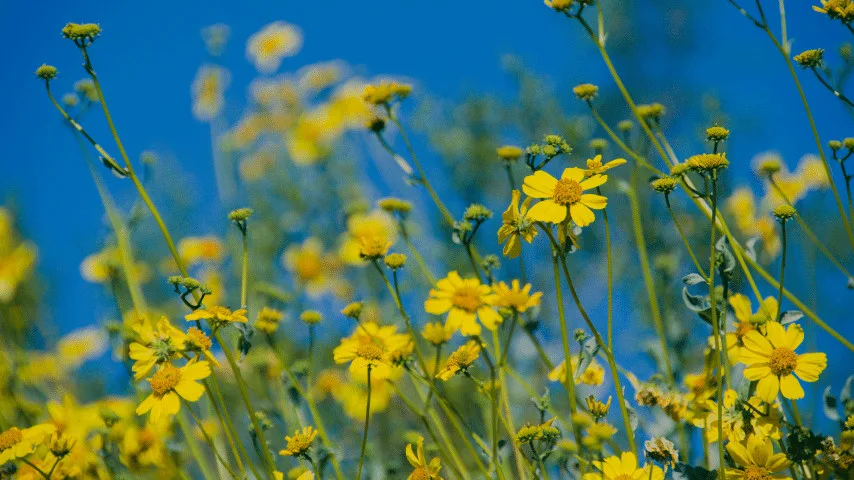
Brittlebush is used to make glue and herbal medicines, prefer growing in rocky or well-drained soils
Brittlebush belongs to the family of shrubs, with a rounded structure and brittle stems.
To date, Brittlebush is used to make glue and herbal medicines.
They can grow up to a height between 2-5 ft, depending upon growing conditions and other environmental factors.
They prefer growing in rocky or well-drained soils.
Scientific Name and Nomenclature
- Scientific name: Encelia farinosa
- Family: Daisy
- Temperature: Can withstand hot temperatures
- Fertilizer: No fertilizers required
- pH: 6.6-8.5
- Soil: Rocky, sandy and well-drained
- Lighting: Full sun
- Growth rate: Slow
- Humidity: 0-10%
7. Creosote Bush

Creosote Bush does well in desert conditions, competing with other plants for water in the soil
Creosote Bush is also considered a medium-sized shrub that stays evergreen throughout the year.
They have waxy coated small, pointed leaves which are accustomed to reducing the water loss due to transpiration.
They do well in desert conditions, competing with other plants for water in the soil.
Scientific Name and Nomenclature
- Scientific name: Larrea tridentata
- Family: Caltrops
- Temperature: 117°F (47°C)
- Fertilizer: No fertilizers required
- pH: 6.5-8.5
- Soil: Well-drained and loose soil type
- Lighting: Ample sunlight
- Growth rate: Slow
- Humidity: 0-10%
8. Desert Ironwood Plant
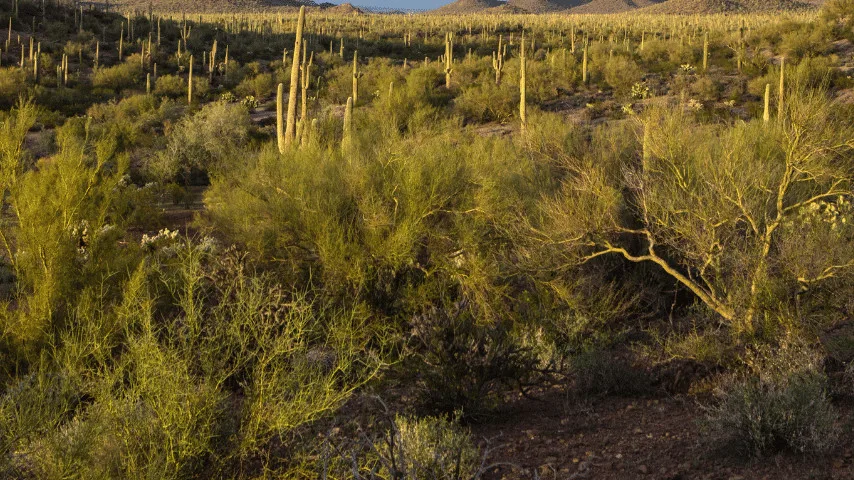
Desert Ironwood Plant is adapted to intense heat and scarcity of water throughout the season
Desert Ironwood Plant, also known as Palo Fierro, is found across the bordering regions of the US and Mexico.
Desert Ironwood Plant indicates bats migrate through its changing flowering pattern.
Desert Ironwood Plant is adapted to intense heat and scarcity of water throughout the season.
Scientific Name and Nomenclature
- Scientific name: Olneya tesota
- Family: Legumes
- Temperature: Can survive in extreme heat and temperatures
- Fertilizer: No fertilizers required
- pH: 6.6-8.5
- Soil: Dry, well-drained, and low in organic content
- Lighting: Full sun
- Growth rate: Slow
- Humidity: 0-10%
9. Desert Sage Plant
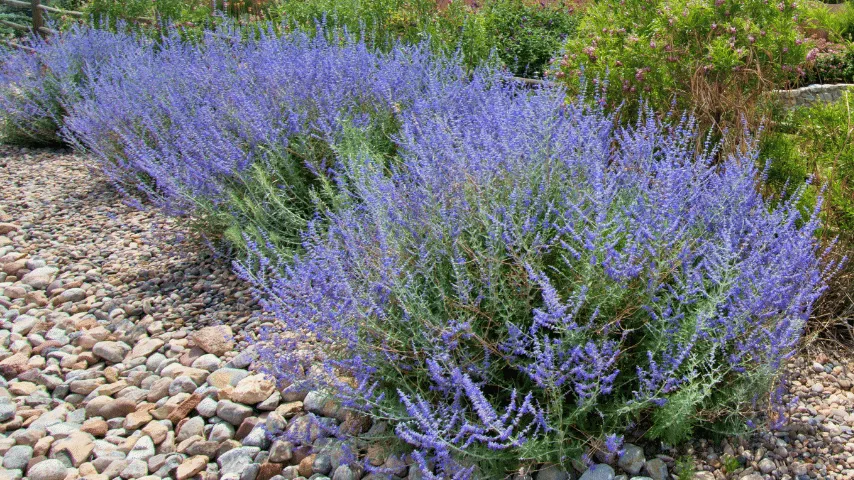
Desert Sage Plant grows up to a height of 2-3 meters depending upon desert conditions and terrain
Desert Sage Plant, also called Sand Sage, produces alluring deep blue flowers during the seasons: spring and summer.
They can grow up to a height of 2-3 meters depending upon desert conditions and terrain.
The Desert Sage Plant is used to manufacture herbal remedies that are used to cure a variety of ailments.
Scientific Name and Nomenclature
- Scientific name: Salvia dorrii
- Family: Lamiaceae
- Temperature: Around 104°F (40°C)
- Fertilizer: No fertilization required
- pH: 6.0-8.5
- Soil: Well-drained sandy, rocky, or loamy
- Lighting: At least 6 hrs. of intense sunlight
- Growth rate: Slow
- Humidity: 0.69%
10. Desert Marigold
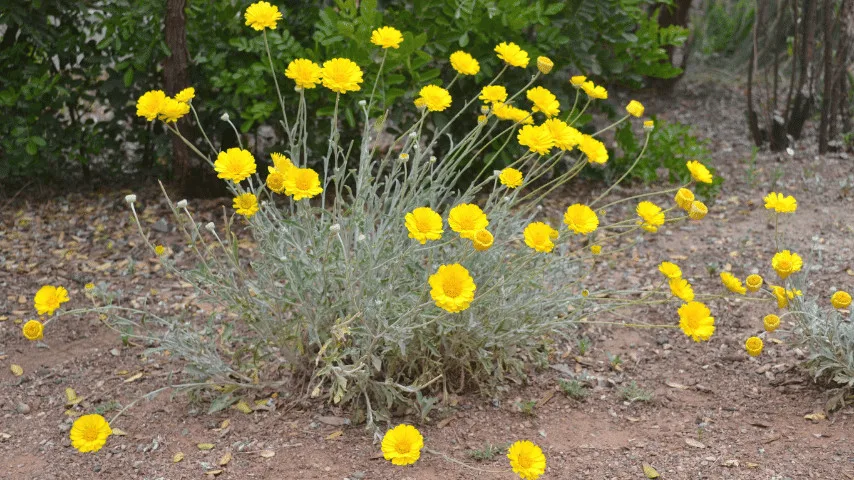
Desert Marigold. the attractive yellowish flower that keeps blossoming throughout any seasons
Desert Marigold is an attractive yellowish flower that keeps blossoming throughout spring, summer, and at times during the fall season as well.
They can grow up to 10-30 inches. Desert Marigold can be referred to as Paper daisy due to its papery texture as it reaches a mature age.
Scientific Name and Nomenclature
- Scientific name: Baileya
- Family: Daisy family
- Temperature: Thrives in extreme heat
- Fertilizer: 15-15-15 NPK fertilizer
- pH: 7-9
- Soil: Dry or poor soils
- Lighting: Full sun
- Growth rate: Slow
- Humidity: 1-10%
11. Desert Willow Tree
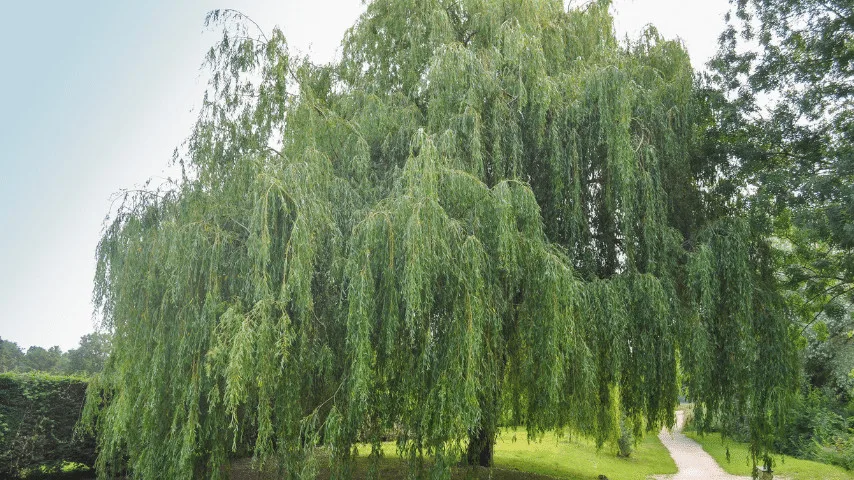
Desert Willow Tree is very common throughout the desert regions, capable of thriving in the heat and tough conditions
Desert Willow Tree is a delicate small tree with a twisted trunk and a spreading crown.
Desert Willow is very common throughout the desert regions of the US and Mexico, as its capable of thriving in the heat and tough conditions.
Pinkish lavender flowers bloom from May to September, depending upon surroundings and environmental conditions.
Scientific Name and Nomenclature
- Scientific name: Chilopsis linearis
- Family: Bignonia family
- Temperature: Thrives in extreme heat
- Fertilizer: Applying an all-purpose fertilizer is recommended
- pH: 6.6-8.5
- Soil: Dry to moist
- Lighting: Full sun
- Growth rate: Slow
- Humidity: 1-10%
12. Desert Lily
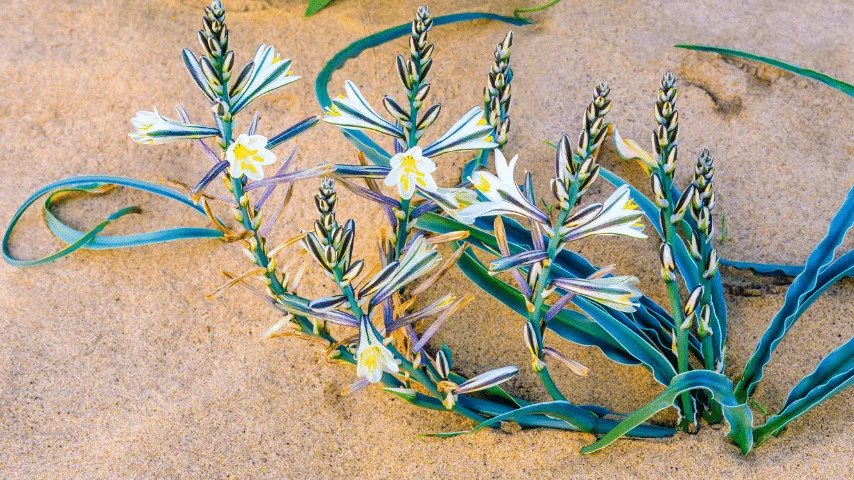
Desert Lily fully produces cream white-colored flowers, adapted to desert conditions.
Desert Lily is a flowering plant known as Ajo Lily that is fully adapted to desert conditions.
Desert Lily isn’t found in high volumes, as Lilies can be tough to plant.
Desert Lily produces cream white-colored flowers which have a blooming period from March-May.
Scientific Name and Nomenclature
- Scientific name: Hesperocallis undulata
- Family: Asparagus
- Temperature: Extreme temperatures and dry climate
- Fertilizer: Water-soluble fertilizers
- pH: 6.6-7.5
- Soil: Well-drained or sandy
- Lighting: Sunny location
- Growth rate: Slow
- Humidity: 20-40%
13. Turpentine Broom

Turpentine Broom is considered a shrub with broom-like straight branches, that thrives in desert areas
Turpentine Broom, also known as Thamnosma Montana is considered a shrub with broom-like straight branches that are often seen without leaves.
Their leaves grow slowly and are very small in size. When the plant reaches a mature age, one can observe royal purplish petals growing near resin glands.
Turpentine Broom has a strikingly vivid appearance with flowers on it.
Scientific Name and Nomenclature
- Scientific name: Thamnosma Montana
- Family: Citrus family
- Temperature: Can withstand temperatures as low as 10°F
- Fertilizer: No fertilization required
- pH: 6.5-8.0
- Soil: Grows in any soil type
- Lighting: Bright sunlight
- Growth rate: Slow
- Humidity: 0-10%
14. Mojave-aster
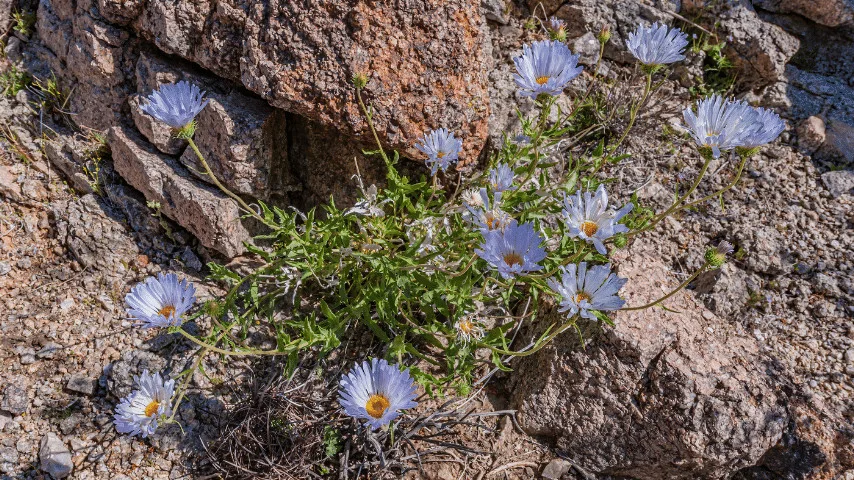
Mojave-aster thrives in rocky and sandy deserts at an elevation of 2000-5500 ft
Mojave-aster belongs to the Sunflower family, with an ability to grow about 30 inches tall.
Mojave-aster can be classified as a shrub perennial having a gray-green structure with a small stem and a beautiful white flower.
It thrives in rocky and sandy deserts at an elevation of 2000-5500 ft, like the Grand Canyons.
Scientific Name and Nomenclature
- Scientific name: Xylorhiza tortifolia
- Family: Asteraceae
- Temperature: Survives in the desert heat
- Fertilizer: Applying 5-10-10 fertilizer is ideal
- pH: 7.0-8.0
- Soil: Well-drained or sandy soil
- Lighting: Bright sunlight
- Growth rate: Slow
- Humidity: 0-10% (Minimum humidity)
15. Jumping Cholla
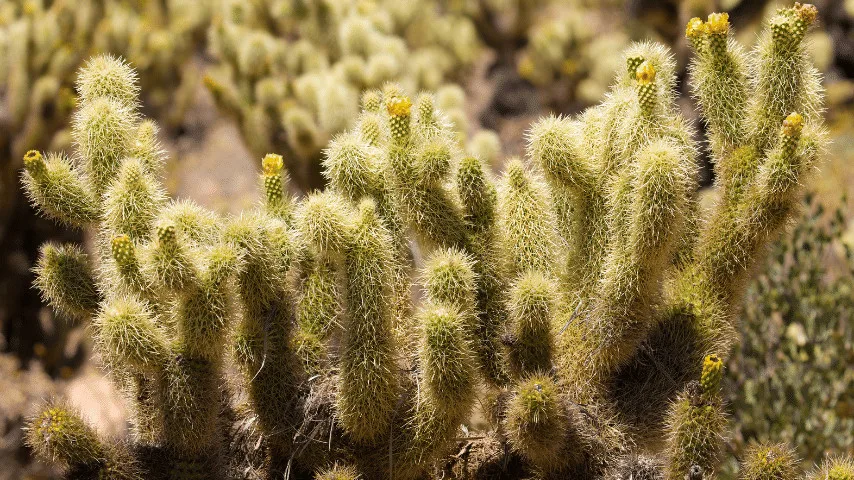
Jumping Cholla starts blooming from February onwards till May, offering a beautiful sight in a harsh desert
Jumping Cholla breeds from the Cactus family and isn’t poisonous like other Cactus varieties.
One of the most attractive features of Jumping Cholla is its spines, having hundreds of little spikes which can get attached to almost everything.
Jumping Cholla can grow up to 1-2 ft depending upon surrounding and growing conditions.
Greenish flowers start blooming from February onwards till May, offering a beautiful sight in a harsh desert.
Scientific Name and Nomenclature
- Scientific name: Cylindropuntia fulgida
- Family: Cactus
- Temperature: Variable temperature conditions
- Fertilizer: Applying 5-10-10 or 10-10-10 with a 1/4th strength
- pH: 6.0-7.5
- Soil: Well-drained soil with excess grit
- Lighting: Thrives well in a sunny location
- Growth rate: Slow
- Humidity: Minimum humidity
16. Joshua Tree
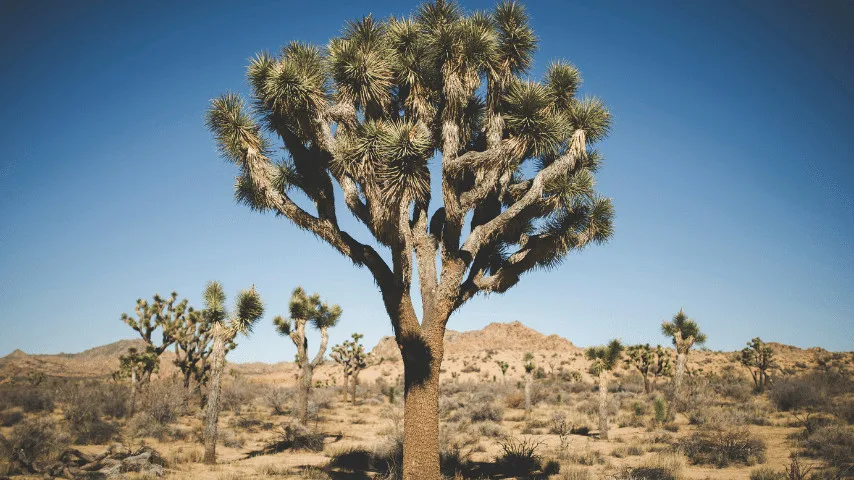
Joshua Tree is a shelter or a home to many birds and species in the deserted area
There’s still confusion either Joshua Tree is classified as a tree or a Cactus.
Joshua is known to pick pace while growing and extend up to 15-40 ft in height.
Joshua Tree is a shelter or a home to many birds and species in the deserted area.
Moreover, it adapted to a severe arid climate, and that’s why it’s primarily found in deserts.
Scientific Name and Nomenclature
- Scientific name: Yucca brevifolia
- Family: Asparagus
- Temperature: 35-99°F (40°C) or even above 105°F
- Fertilizer: Mild or slightly acidic fertilizer is required
- pH: 5.6-8.0
- Soil: Alkaline, Acidic, and neutral
- Lighting: Bright light
- Growth rate: Slow
- Humidity: Minimum 2% humidity
17. Ocotillo
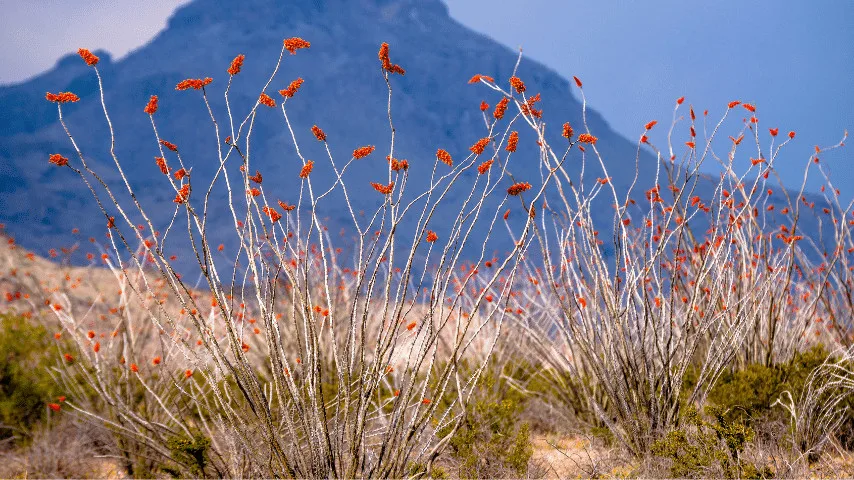
Ocotillo does well in arid climates with little or no moisture in the air, common in harsh desert regions
Ocotillo is also known as Fouquieria splendens are quite common in harsh desert regions.
They are spring uprooted from a short trunk, growing into spiny stems.
Ocotillo might require some maintenance and cleaning during its non-growing season.
Ocotillo does well in arid climates with little or no moisture in the air.
Scientific Name and Nomenclature
- Scientific name: Fouquieria splendens
- Family: Fouquieriaceae
- Temperature: Up to 123°F (50°C)
- Fertilizer: No additional fertilizers are required
- pH: 6.0-8.0
- Soil: Gravelly loamy soil is ideal
- Lighting: Full sun
- Growth rate: Slow
- Humidity: Low humidity is ideal
18. Yellow Paloverde
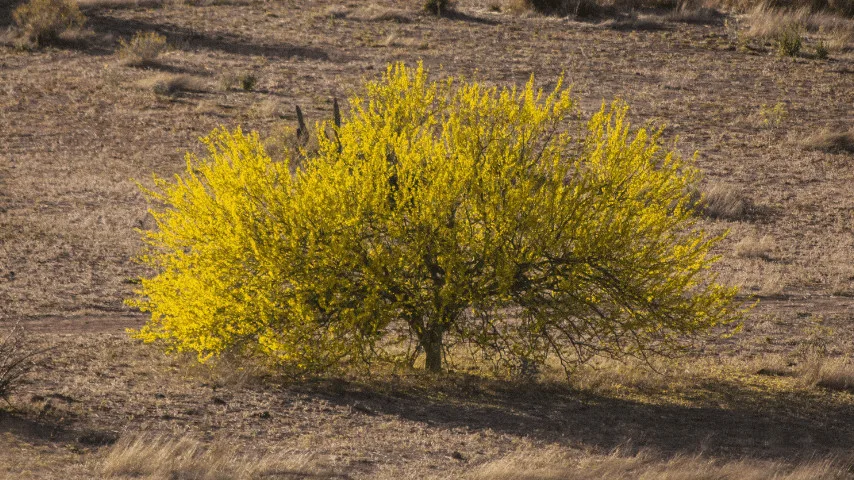
Yellow Paloverde a thrive in extreme cold and drought situations, depending on regional temperatures and settings
Yellow Paloverde has impressive lengths as it can grow up to 20ft.
Initially, they experienced a stunted growth, but with time they tend to grow in volume, resembling bushes.
Yellow Paloverde can thrive in extreme cold and drought situations, depending on regional temperatures and settings.
Scientific Name and Nomenclature
- Scientific name: Parkinsonia microphylla
- Family: Legumes
- Temperature: Upto 40-65°F (5-18°C)
- Fertilizer: No fertilization required
- pH: 5.6-8.5
- Soil: Gravelly loamy soil is ideal
- Lighting: Full sun
- Growth rate: Slow or moderate (depending on availability of water)
- Humidity: Low humidity
19. Triangle-leaf Bursage
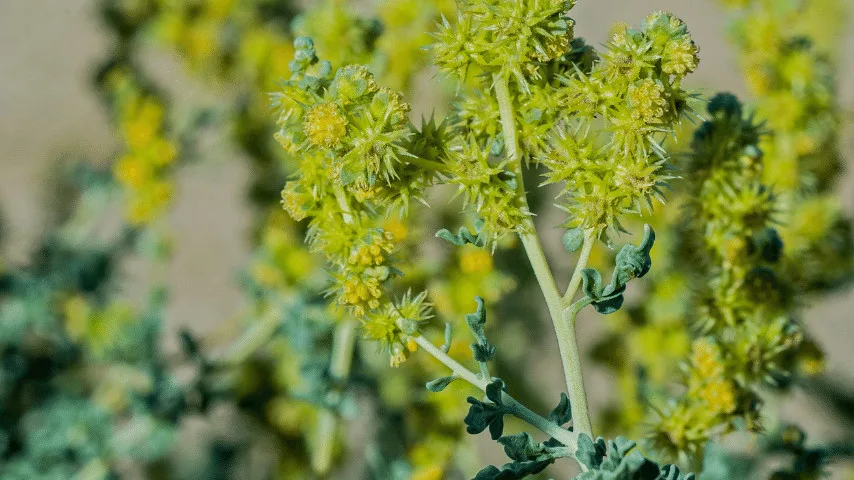
Triangle-leaf Bursage is ideal for enriching the soil’s nutritional content in the desert region
Triangle-leaf Bursage contributes most towards the development of desert flora.
Triangle-leaf bursage grows on reclaimed lands which have been overgrazed previously.
They are ideal for enriching the soil’s nutritional content in the desert region. It can grow up to 1ft in height on gravelly, steep, and flat hills.
Scientific Name and Nomenclature
- Scientific name: Ambrosia deltoidea
- Family: Sunflower
- Fertilizer: No fertilization is necessary
- pH: Depends upon rainfall
- Soil: Coarse soils (High in pH)
- Lighting: Full sun to light shade
- Growth rate: Moderate
- Humidity: Optimum humidity
20. Desert Palm
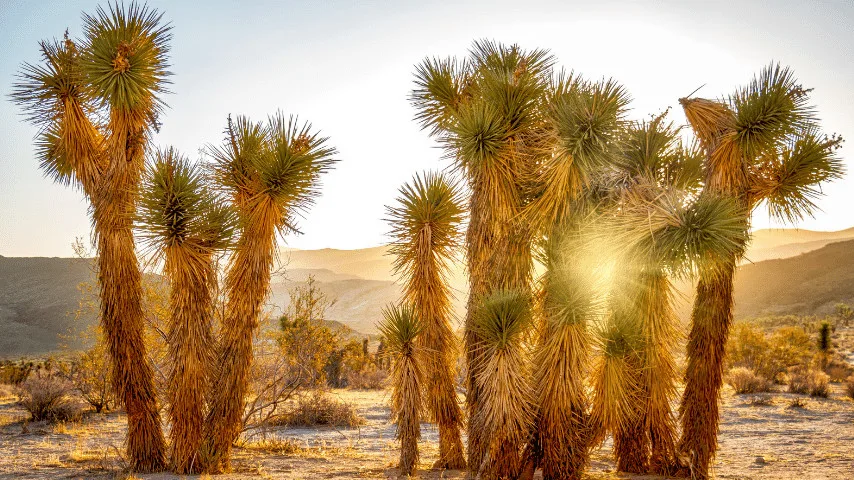
Desert Palm is a long-lasting and durable plant which are found in very few desert regions
Desert Palm is a long-lasting and durable plant which are found in very few desert regions across the globe.
Their hanging trunk posture protects subgrade soils and plants growing on the foothills of Desert Palm.
If you are passing through a desert, you might see a bunch of Palm Trees forming a pleasant oasis.
Scientific Name and Nomenclature
- Scientific name: Washingtonia filifera
- Family: Palms
- Temperature: Upto 122°F (50°C)
- Fertilizer: Applying 12-4-12-4 special palm fertilizer in measured ratio
- pH: 6-7
- Soil: Gravelly, sandy, and well-drained
- Lighting: Plenty of sunlight
- Growth rate: Moderate
- Humidity: Can tolerate high moisture
21. Tumbleweed
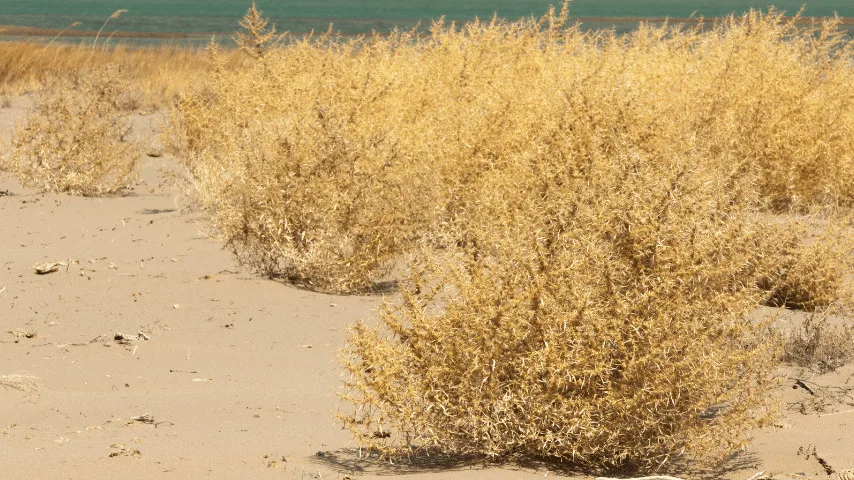
Tumbleweed is a harsh plant that breaks contact with its roots and moves away, common on abandoned desert lands
Few hobbyists and gardeners label Tumbleweed as a harsh plant that breaks contact with its roots and moves away.
Tumbleweed has the shape of a Russian Thistle, having the ability to grow up to 5.5 ft in height.
Tumbleweed is quite common on abandoned desert lands that are barren.
Scientific Name and Nomenclature
- Scientific name: Salsola
- Family: Amaranthaceae
- Temperature: Upto 160°F (72°C)
- Fertilizer: Add compost conditioner if required
- pH: 7.6-9.0
- Soil: Sandy soils
- Lighting: Bright light
- Growth rate: Moderate
- Humidity: Low or minimum humidity levels
22. Mesquite Tree
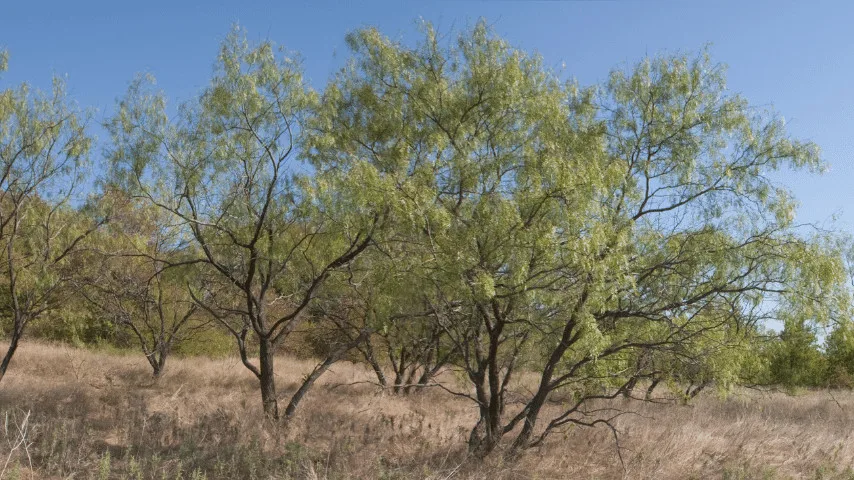
Mesquite Tree, used in the making of herbal medicines, mostly found in dry areas
There are about 40 distinctive species of Prosopis with a common name, Mesquite.
They are mostly found in dry areas, where there is little humidity and plants can survive long spells of the harsh climate.
Mesquites are home to Hummingbirds mainly and are used in the making of herbal medicines.
Scientific Name and Nomenclature
- Scientific name: Prosopis glandulosa
- Family: Fabaceae
- Temperature: 80-85°F (27-30°C)
- Fertilizer: Fertilize using Ammonium Sulphate during the spring season only
- pH: 5.5-7.0
- Soil: Rich in organic content, sandy or gritty
- Lighting: Full sun
- Growth rate: Slow
- Humidity: 1-5% depending upon soil type
23. Poison Ivy
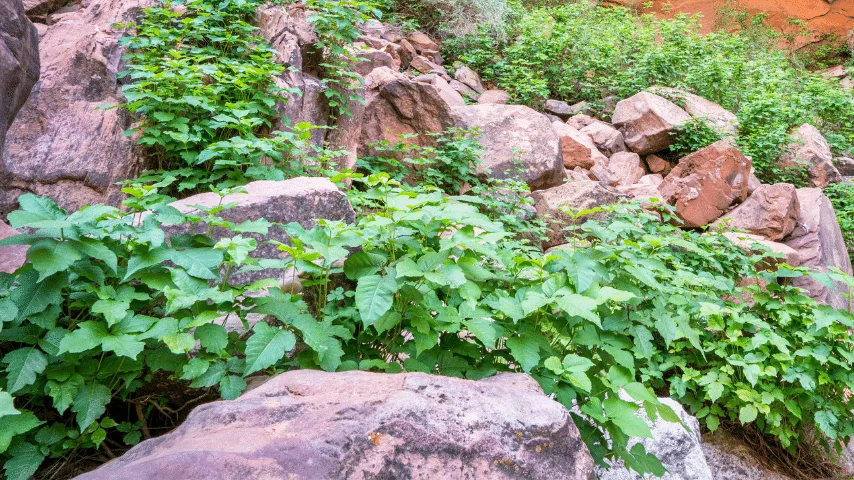
Poison Ivy is smooth with a dull or glossy surface depending upon the weather and other environmental
Poison Ivy has a very rare structure comprising compound leaves, leaflets, and a long stalk.
The edges of Poison Ivy are smooth with a dull or glossy surface, depending upon the weather and other environmental characteristics.
This unique-looking plant can cause blisters and red patches if not handled with care.
Scientific Name and Nomenclature
- Scientific name: Toxicodendron radicans
- Family: Cashews
- Temperature: High temperatures stimulate its growth
- Fertilizer: Monitored use of 2,4-D Amine and Dicamba treatment
- pH: 3.6-6.5
- Soil: Moist, fertile, and well-drained
- Lighting: Full sun or shade
- Growth rate: Moderate
24. Date Palm
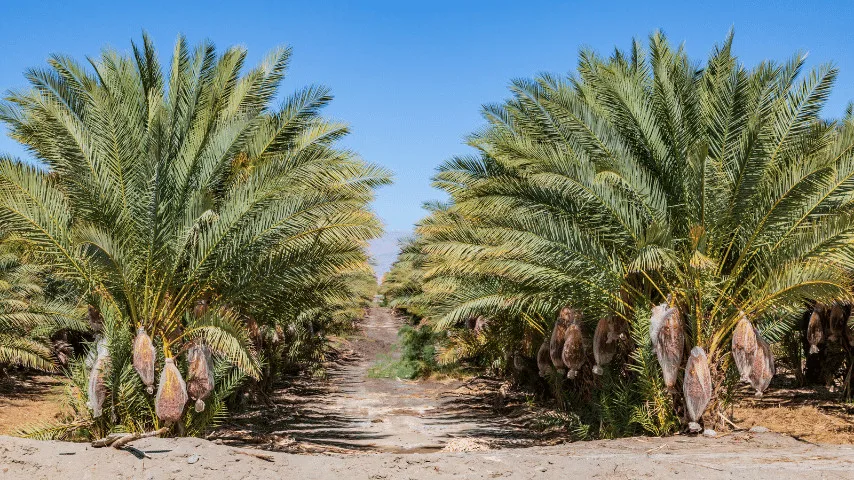
Date Palm is known for producing sweet and tasty edible fruits and is very common in the desert region
Date Palm is known for producing sweet and tasty edible fruits and is very common in the region having an arid and tough climate.
Date Palm is quite similar to Palm Trees, but not every Palm produces dates.
Scientific Name and Nomenclature
- Scientific name: Phoenix dactylifera L.
- Family: Arecaceae
- Temperature: Thrives well around 95°F (35°C)
- Fertilizer: Applying 4-1-6-2 NPKM fertilizer is recommended
- pH: 7.0-8.0
- Soil: Clayey, loamy, sandy
- Lighting: Bright light to partial shade
- Growth rate: Slow
- Humidity: Around 50% at the time of plantation
25. Lovegrass
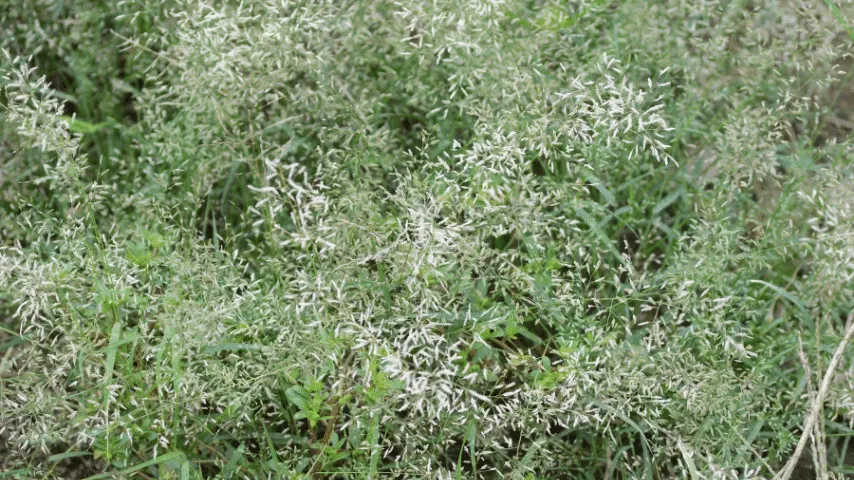
Lovegrass doesn’t require much maintenance as they keep growing, and thrives well in sandy soil
Lovegrass is classified as tufted and perennial annuals belonging to the family of Poaceae.
Lovegrass is found in regions having a temperate and tropical climate and thrives well in sandy soil.
Lovegrass doesn’t require much maintenance as they keep growing and expanding throughout the season.
Scientific Name and Nomenclature
- Scientific name: Eragrostis
- Family: Poaceae
- Temperature: Thrives well around 77-86°F (25-30°C)
- Fertilizer: Apply 30lbs per acre of Nitrogen
- pH: 7.0-8.5
- Soil: Sandy, loamy, clay, and well-drained
- Lighting: Full sun to partial shade
- Growth rate: Slow
- Humidity: Little moisture is ideal
26. Thyme
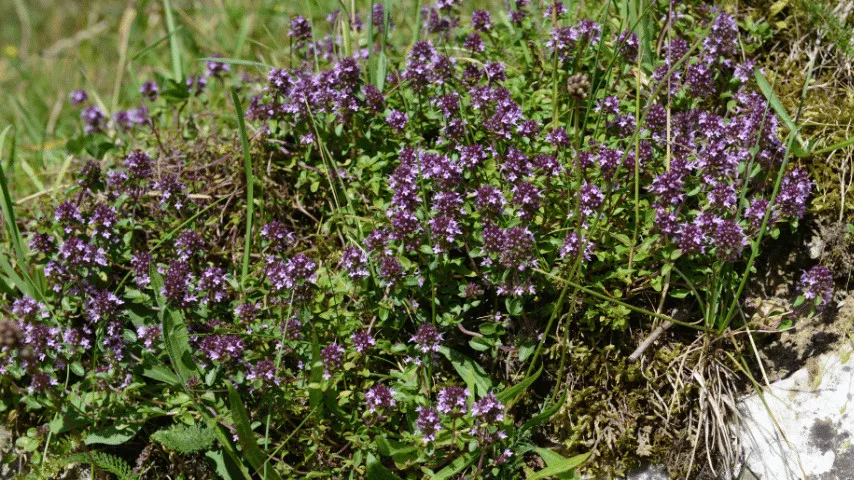
Thyme thrives well in a low land desert area having ideal temperatures, moisture, and humidity.
Thyme is considered an aromatic perennial herb that stays evergreen throughout the season.
Thyme can also be grown under a hydroponics system for its medical benefits.
Thyme can thrive well in a low land desert area having ideal temperatures, moisture, and humidity.
Scientific Name and Nomenclature
- Scientific name: Thymus vulgaris
- Family: Mints
- Temperature: 40-82°F (4-28°C)
- Fertilizer: Apply common nitrogen-based fertilizers
- pH: 6.6-8.5
- Soil: Rocky, loose, sandy, and well-drained
- Lighting: Prefers a sunny area
- Growth rate: Slow
- Humidity: Doesn’t like humidity
27. Oleander
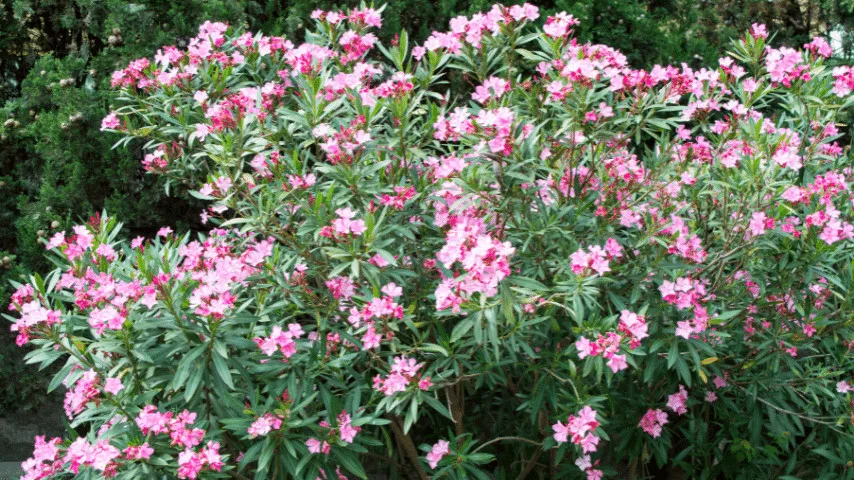
Oleander is a type of shrub which is very common in deserts and gardens
Oleander is a type of shrub which is very common in deserts and gardens. It has a poisonous milky substrate or juice,
which can cause problems for humans and animals if eaten. Its flower blooms all year round, without any proper care or maintenance.
Scientific Name and Nomenclature
- Scientific name: Nerium oleander
- Family: Dogbanes
- Temperature: High desert temperatures
- Fertilizer: No fertilization required
- pH: 6.5-7.5
- Soil: Grows well in alkaline soil type
- Lighting: Full sun or partial shade
- Growth rate: Slow
- Humidity: Optimum humidity
28. Emu Bush
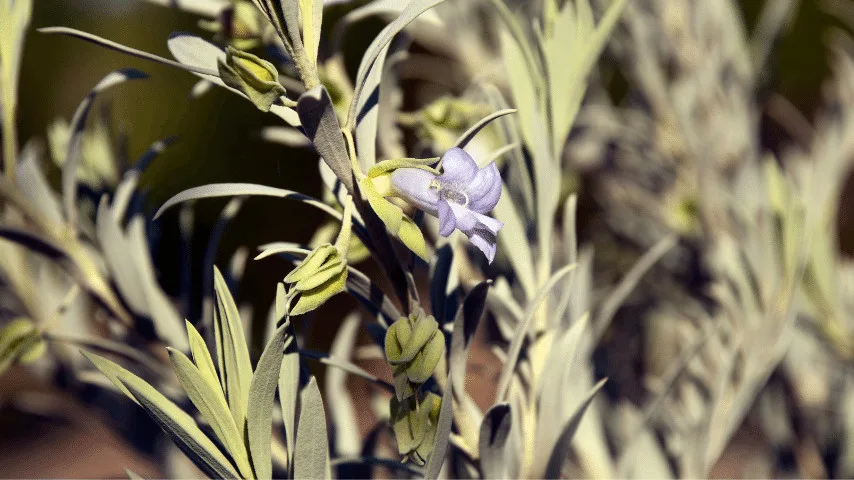
Emu Bush produces soft green fruit and red flowers, quite popular in desert regions
Emu Bush is also a shrub having green foliage and symmetrical growth. They are quite popular in desert regions of Australia,
where they enjoy optimum sunlight, heat, and moisture. Upon maturity, it produces soft green fruit and red flowers.
Scientific Name and Nomenclature
- Scientific name: Eremophila glabra
- Family: Figworts
- Temperature: Thrives well in warm temperatures
- Fertilizer: Fertilizers rich in phosphorus
- pH: 5.6-8.5
- Soil: Sandy, Loamy, or any poor soil
- Lighting: Enjoys staying in a sunny location
- Growth rate: Slow
- Humidity: Prefers drier areas
29. Pinyon Pine
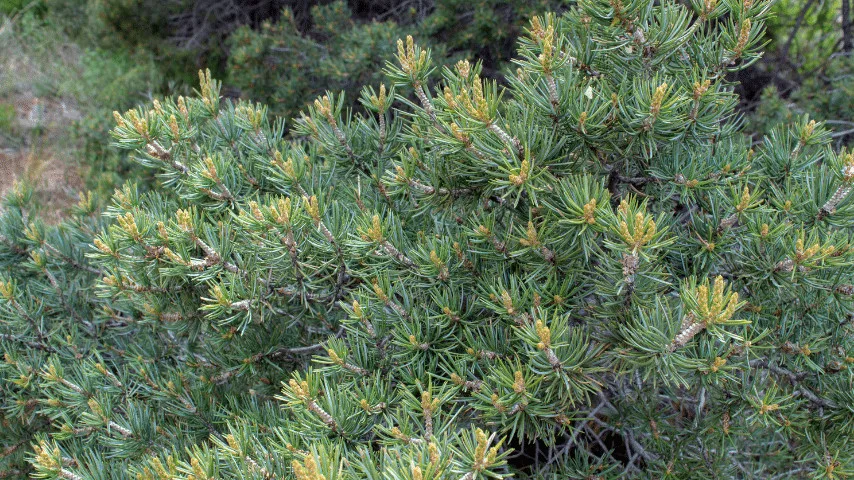
Pinyon Pine adapted to desert climates as it can withstand extreme heat and drought
Pinyon Pine is capable of growing up to 30 ft in height and producing pine nuts which are used as a raw material in the making of pasta sauce.
Pinyon Pine is well adapted to desert climates as it can withstand extreme heat and drought.
Scientific Name and Nomenclature
- Scientific name: Pinus edulis Engelm
- Family: Pinaceae
- Temperature: 68°F (20°C)
- Fertilizer: Doesn’t need fertilization
- pH: 6.5-8.4
- Soil: Sandy, silty loam, well-drained, and clayey
- Lighting: 15 hrs. of uninterrupted sunlight
- Growth rate: Slow
30. Ficus
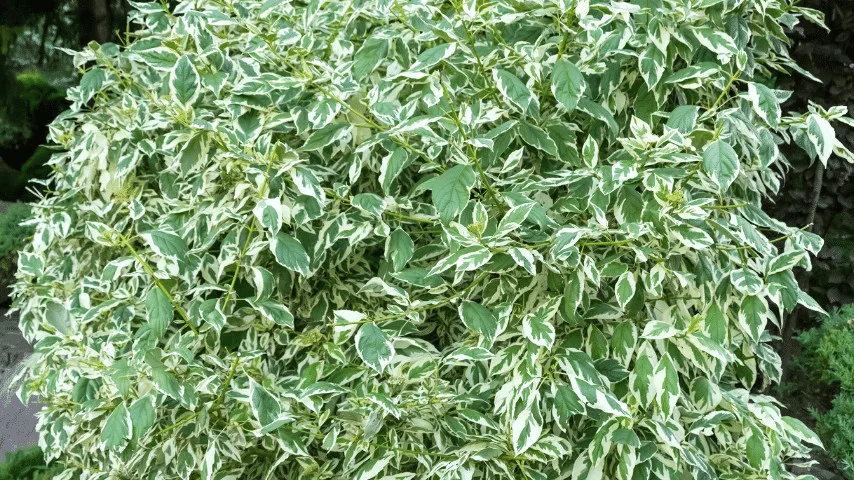
Ficus desert plants have thick and dense green leaves, providing shade in the desert.
Ficus desert plants have thick and dense green leaves, providing shade in the desert.
There are over 900 species of Ficus, which are adapted to hot and tough desert conditions.
Depending on climate and other environmental conditions, Ficus grows well in sandy and rocky soils.
Scientific Name and Nomenclature
- Scientific name: Ficus Benjamina
- Family: Moraceae
- Temperature: 55-75°F (12-24°C)
- Fertilizer: Nitrogen-based fertilizers
- pH: 6.5-7.0
- Soil: Well-drained and fertile soil
- Lighting: Bright or indirect sunlight
- Growth rate: Moderate
- Humidity: Around 40%
Conclusion
There is a very large variety of plants that can withstand extreme temperatures and tough conditions in deserts and other settings.
Not every gardener or hobbyist can spend time maintaining their plants and their different requirements.
Hence, the plants mentioned above are accustomed to little or no maintenance, making them ideal for areas with high temperatures and less rain.

